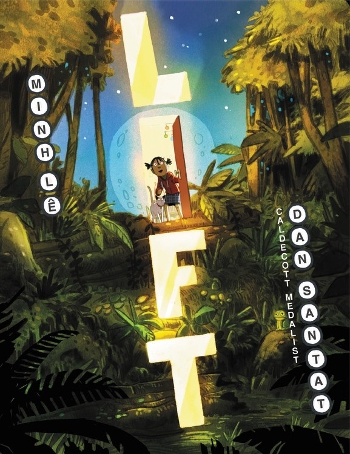While the Caldecott criteria relegate “overall book design” to the very last line, as a reader I almost always start with book design. And I did so with Lift, written by Minh Lê and illustrated by Dan Santat.
 I tried to resist Lift, written by Minh Lê and illustrated by Dan Santat — a story of sibling rivalry in which young protagonist Iris feels usurped by her younger brother until she presses a magical elevator button that lets her escape into fantastic adventures. I saw it when it was published in May, and I put it aside. But then, I’d be reading the newspaper over breakfast and the little girl’s face, green with sibling jealousy, would cross my mind. The book’s haunting cover summoned me with an overgrown, Rousseau-ian forest permeated by a single, off-center vertical beam of light made by the letters L-I-F-T. Clever embossing makes this shaft of light shiny and reflective. And there, centered against the moon and opening a door toward the reader, stands a wide-eyed, pony-tailed girl and her equally amazed cat.
I tried to resist Lift, written by Minh Lê and illustrated by Dan Santat — a story of sibling rivalry in which young protagonist Iris feels usurped by her younger brother until she presses a magical elevator button that lets her escape into fantastic adventures. I saw it when it was published in May, and I put it aside. But then, I’d be reading the newspaper over breakfast and the little girl’s face, green with sibling jealousy, would cross my mind. The book’s haunting cover summoned me with an overgrown, Rousseau-ian forest permeated by a single, off-center vertical beam of light made by the letters L-I-F-T. Clever embossing makes this shaft of light shiny and reflective. And there, centered against the moon and opening a door toward the reader, stands a wide-eyed, pony-tailed girl and her equally amazed cat.
While the Caldecott criteria relegate “overall book design” to the very last line, as a reader I almost always start with book design. That Santat made the jacket design gives it particular importance in this “pictorial presentation” of imagination and escape from family stresses.
Take off the book jacket to find that the paperboard covers develop the story. The front cover is a dark green, a great green room cast in eerie bedtime darkness. The room’s furniture balances the composition with a table on the right and the left, some family pictures, a lamp and clock. Things seem stable, except for that unearthly door that seems to pulsate. Light glows from an elevator button taped to the wall. If I were presenting this title at a Caldecott committee discussion, I’d stress the predictive opportunities of this cover. To whom do that fallen teddy bear and ball belong? What’s this elevator button got to do with the girl? With magic? Is the door opening or closing?
While the back cover might suggest that the story is over, this one focuses on a threshold and anticipates the book’s open ending. Positioned in the forest, the reader looks into the room to see shadowy pictures on the wall, a bookcase, and a mirror image of the dropped teddy bear and abandoned ball. Flip the book over and open it. Rendered in the sepia tones of tinted nostalgic photographs, these endpapers function as the book’s first double-page spread. The pony-tailed girl stands at attention on the recto and casts a long shadow into the off-kilter rectangle of brilliant white that crosses the gutter. She dominates the picture space as she looks in wonder into the light in front of her. On the entrance to adventure, this insistent page-turn leads to the title page that depict a spare lobby where a family waits in front of the elevator. Yes, this is the same girl, though she looks much smaller between her parents. Here’s the first view of that stuffed tiger, held by her brother. The questions multiply as the connections build.
The next two pages provide establishing shots for days of the week, introduce Iris as first-person narrator, and set up the reading strategies for the panel art. Those reading strategies continue to invite reader engagement. Is the tiger that her brother holds also named Iris? What happens if Iris can’t push the elevator button? What does betrayal feel like? What happens when she pushes all the elevator buttons at once? What happens when she tapes the discarded button from the now-fixed elevator to her bedroom wall? The real adventure begins after a cheerful babysitter puts Iris to bed: “DING!”
[Read the Horn Book Magazine review of Lift here]
Throughout Lift, art and text comment on each other as familiar objects appear in the real and imagined worlds, as perspectives change in the art and characters, and as readers are invited to make connections between and across panels, just as Iris makes new emotional connections.

ALREADY A SUBSCRIBER? LOG IN
We are currently offering this content for free. Sign up now to activate your personal profile, where you can save articles for future viewing.








Add Comment :-
Be the first reader to comment.
Comment Policy:
Comment should not be empty !!!